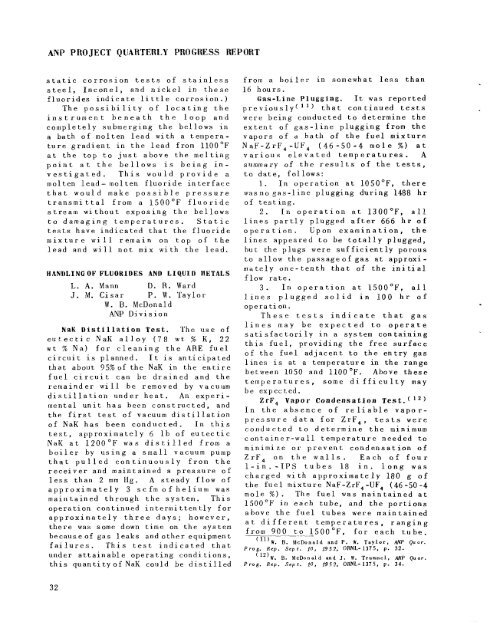the Molten Salt Energy Technologies Web Site
the Molten Salt Energy Technologies Web Site
the Molten Salt Energy Technologies Web Site
You also want an ePaper? Increase the reach of your titles
YUMPU automatically turns print PDFs into web optimized ePapers that Google loves.
AR'P PROJECT QUARTERLY PWOGFWSS REPORT<br />
static corrosion tests of stainless<br />
steel, Inconel, and nickel in <strong>the</strong>se<br />
fluorides indicate little corrosion.)<br />
The possibility of locating <strong>the</strong><br />
instrument beneath <strong>the</strong> Loop and<br />
co~iipletely submerging <strong>the</strong> bellows in<br />
a bath of molten lead with a temperature<br />
gradient in <strong>the</strong> lead from 1100°F<br />
at <strong>the</strong> top to just above <strong>the</strong> melting<br />
point at <strong>the</strong> bellows is hcing investigated.<br />
This would provide a<br />
molten lead- molten fluoride interface<br />
that would makc possible pressure<br />
transmittal from a 1500°F fluoride<br />
stream without exposing <strong>the</strong> bellows<br />
to damaging temperatures. Static<br />
tests have indicated that <strong>the</strong> fluoride<br />
mixture w i l l remain on top of <strong>the</strong><br />
lead and w i l l not mix with <strong>the</strong> lead.<br />
HANDLING OF FLUORIDES AND LIQUID HETALS<br />
L. A. hlann D. R. Ward<br />
J. M. Cisar P. W. 'Taylor<br />
W. B. McDonald<br />
ANP Division<br />
NaK Distillatioa Test. The use of<br />
eutectic NaK alloy (78 w t % K, 22<br />
w t % Na) for cleaning <strong>the</strong> ARE fuel<br />
circuit is planned. It is anticipated<br />
that about 95%of <strong>the</strong> NaK in <strong>the</strong> entire<br />
fuel circuit can be drained and <strong>the</strong><br />
remainder w i l l be removed by vacuum<br />
distillation under heat. An experi-<br />
mental unit has been constructed, and<br />
<strong>the</strong> first test of vacuum distillation<br />
of NaK has been conducted. in this<br />
test, approximately 6 lb of eutectic<br />
NaK at 1200°F was distilled from a<br />
boiler by using a small vacuum pump<br />
that pulled continuously from <strong>the</strong><br />
receiver and maintained a pressure of<br />
less than 2 mm Hg. A steady flow of<br />
approximately 3 scfm of helium was<br />
maintained through <strong>the</strong> system. This<br />
operztion continued intermi tten tly for<br />
approximately three days; however,<br />
<strong>the</strong>re was some down t i m e on <strong>the</strong> system<br />
because of gas leaks and o<strong>the</strong>r equipment<br />
failures. 'This test indicated that<br />
under attainable operating conditions,<br />
this quantityof NaK could be distilled<br />
32<br />
from a boiler in somewhat less than<br />
16 hours.<br />
Gas-Lime Plugging, It was reported<br />
previously( '1 that continued tests<br />
were being conducted to determine <strong>the</strong><br />
extent of gas-line plugging from <strong>the</strong><br />
vapors of a bath of <strong>the</strong> fuel mixture<br />
NaF-ZrF,-UF, (46-50-4 mole %) at<br />
various elevated temp era tu res. A<br />
summary of <strong>the</strong> results of <strong>the</strong> tests,<br />
to date, follows:<br />
I.. In operation at 1050"F, <strong>the</strong>re<br />
wasno gas-line plugging during 1488 hr<br />
of testing.<br />
2. In operation at 1300°F, all.<br />
lines partly plugged after 666 hr of<br />
operation. Upon examination, <strong>the</strong><br />
lines appeared to be totally plugged,<br />
hut <strong>the</strong> plugs were sufficiently parous<br />
to allow <strong>the</strong> passageof gas at approximately<br />
one-tenth that of <strong>the</strong> initial<br />
flow rate.<br />
3. In operation at 1500"F, all<br />
lines plugged solid in 100 hr of<br />
opera ti on.<br />
These tests indicate that gas<br />
lines may be expected to operate<br />
satisfactorily in a system containing<br />
this fuel, providing <strong>the</strong> free surface<br />
of <strong>the</strong> fuel adjacent to <strong>the</strong> entry gas<br />
lines is at a temperature in <strong>the</strong> range<br />
between 1050 and 1100°F. Above <strong>the</strong>se<br />
temperatures, some difficulty may<br />
be expected.<br />
ZrF, Vapor Condensation Test. ( 12)<br />
In <strong>the</strong> absence of reliable vaporpressure<br />
data for ZrF,, tests were<br />
conducted to determine <strong>the</strong> minimum<br />
c ont aine r-wa 11 t emperatur e needed to<br />
minimize or prevent condensation of<br />
ZrE', on <strong>the</strong> walls. Each of four<br />
1-in.-IPS tubes 18 in. long was<br />
charged with approximately 180 g of<br />
<strong>the</strong> fuel mixture NaF-ZrF,-UF, (46-50-4<br />
mole 7%). The fuel was maintained at<br />
1500°F in each tube, and <strong>the</strong> portions<br />
above <strong>the</strong> fuel tubes were maintained<br />
at different temperatures, ranging<br />
from 900 to . 1500"F, for each tube.<br />
('''W. B. McDonald and P. W. Taylor, ANf Quar.<br />
Prog. Rep. Sept. 10, 1952, ORNL-1375. p. 32.<br />
(12)W. B. McDonald and J. W. Trurnmel,<br />
frog. Rep. Sept. 10, 1952, ORNL-1375, p.<br />
ANf Quar.<br />
34.



![Review of Molten Salt Reactor Physics Calculations [Disc 2]](https://img.yumpu.com/21979492/1/190x247/review-of-molten-salt-reactor-physics-calculations-disc-2.jpg?quality=85)












